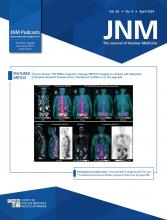Abstract
Background: The goal of this study was to compare the value of contrast-enhanced MRI and O-(2-[18F]fluoroethyl)-L-tyrosine (18F-FET) PET for response assessment in glioma patients following adjuvant temozolomide chemotherapy (TMZ). Methods: After biopsy or resection and completion of radiotherapy with concomitant TMZ, 41 newly diagnosed and histomolecularly characterized glioma patients (glioblastoma, 90%; age range, 20-79 years) were subsequently treated with adjuvant TMZ. MR and 18F-FET PET imaging were performed at baseline and after the second cycle of adjuvant TMZ. We obtained 18F-FET metabolic tumor volumes (MTV) as well as mean and maximum tumor-to-brain ratios (TBRmean, TBRmax). Threshold values of 18F-FET PET parameters to predict outcome were established by ROC analyses using a median progression-free survival (PFS) of ≥9 months and overall survival (OS) of ≥15 months as reference. MRI response assessment was based on RANO criteria. The predictive value of changes of 18F-FET PET and MRI parameters on survival was evaluated subsequently using univariate and multivariate survival estimates. Results: After two cycles of adjuvant TMZ chemotherapy, a treatment-induced reduction of MTV and TBRmax predicted a significantly longer PFS and OS (both P ≤ 0.03; univariate survival analyses) while RANO criteria were not significant (P > 0.05). Multivariate survival analysis revealed that TBRmax changes predicted a prolonged PFS (P = 0.012) and changes of MTV a prolonged OS (P = 0.005) independent of O6-methylguanine-DNA-methyltransferase promoter methylation and other strong prognostic factors. Conclusion: Changes of 18F-FET PET parameters appear to be helpful for identifying responders to adjuvant TMZ early after treatment initiation.
- Neurology
- Oncology: Brain
- PET
- Amino acid PET
- metabolic tumor volume
- pseudoprogression
- treatment monitoring
- treatment-related changes
- Copyright © 2020 by the Society of Nuclear Medicine and Molecular Imaging, Inc.







